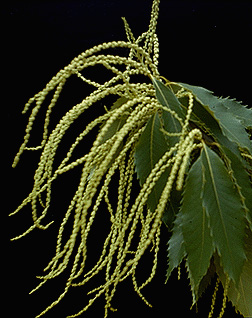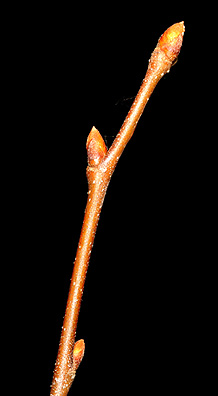American chestnut Fagaceae Castanea dentata
Leaf:Alternate, simple, oblong to lanceolate, 5 to 8 inches long, pinnately veined, sharply and coarsely serrated with each serration bearing a bristle tip, dark green above and paler below, both sides are hairless.
Flower:Species is monoecious; many small, pale green (nearly white) male flowers found tightly occuring along 6 to 8 inch catkins; females found near base of catkins (near twig); appearing in late spring to early summer.
Fruit:Large, round spiny husk (very sharp), 2 to 2 1/2 inch in diameter, enclosing 2 to 3 shiny, chestnut brown nuts, 1/2 to 1 inch in diameter, mostly round but flattened on 1 or 2 sides ripen in early fall.
Twig:Moderately stout, hairless, chestnut- to orange-brown in color, numerous lighter lenticels; buds are orange-brown, 1/4 inch long, covered with 2 or 3 scales (they somewhat resemble a kernel of wheat), buds are set slightly off center from semicircular leaf scar.
Bark:Smooth and chestnut-brown in color when young, later shallowly fissured into flat ridges, older trees develop distictive large, interlacing ridges and furrows. Blight infested bark is sunken and split, often with orange fungal fruiting bodies.
Form:Once a very tall, well formed, massive tree reaching over 100 feet tall. The chestnut is now found mostly as stump sprouts, less than 20 feet tall. Larger stems are often deformed by blight and sprouting below cankers.







Notes: